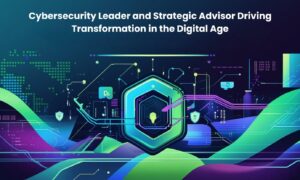Abstract: The article examines the critical importance of cybersecurity in the face of growing threats in the digital space. The main objective of the study is to analyze data and system protection methods, as well as to identify principles that should be implemented to minimize the risks of cyberattacks. The need for a proactive and adaptive approach to cybersecurity is emphasized, including the use of strong passwords, regular software updates, and data backup. The main threats faced by organizations and the importance of employee training are also considered. The practical application of the research results includes the implementation of effective cybersecurity strategies at the organizational and state levels, which can significantly increase the level of protection of critical information and infrastructure.
With increasing interconnectivity through digital networks, the importance of cybersecurity has reached a critical juncture. The risks associated with cyber threats have increased dramatically, encompassing everything from personal devices to global infrastructure. Cybercriminals are becoming increasingly resourceful, targeting individual accounts, large companies and government agencies. The rise of remote working, cloud technology and the Internet of Things has expanded the attack surface, making cybersecurity a priority for everyone. Cybersecurity is not just a technical issue, but an important aspect of modern life that requires investment at all levels to protect our digital world.

The evolving nature of threats requires cybersecurity strategies to take a proactive and adaptive approach. This includes implementing robust defences such as encryption and multi-factor authentication, as well as regularly updating security protocols. Businesses should make cybersecurity a high priority by training employees and auditing systems for vulnerabilities. The need to protect critical infrastructure from cyberattacks at the state level is becoming increasingly evident. National cybersecurity policies and international cooperation are necessary to combat global threats. In addition, everyone should take steps to ensure their cyber security, including using strong passwords and being cautious when dealing with suspicious messages [1].
As one of the main targets of cybercriminals, financial institutions have been at the forefront of cybersecurity efforts for many years. They endeavour to protect the vast amount of sensitive information of their customers, both private and corporate. However, with the proliferation of consumer devices and the rapid adoption of digital platforms, threat levels have increased to unprecedented levels. In the face of this constant change, both financial institutions and digital service providers must learn to expect the unexpected.
Today, cybersecurity must be seen as a way of life, not a tool used only in emergency situations. To effectively counter the ever-growing threats, financial institutions must stay one step ahead. There are many challenges that need to be addressed: cyber warfare, cryptojacking, anti-democratic cyberattacks, cyber espionage and major data breaches. The list is potentially endless and the only possible solution is constant vigilance and the adoption of innovative technologies, as the threat landscape is changing very rapidly [2].
Cybersecurity principles
Cybersecurity plays an important role in protecting and integrating core systems, data and networks. The main objective is to develop, implement and maintain security measures to counter threats and vulnerabilities in cyberspace. The following are the basic principles that should be considered in cybersecurity:
1) Confidentiality
Safeguarding sensitive information by restricting access to authorised users or systems only. This prevents unauthorised disclosure of data.
2) Integrity
Ensuring that data and systems are accurate, consistent and trustworthy. Information must be protected from malicious tampering or alteration.
3) Availability
Ensuring that systems and data are available when needed, minimising downtime and maintaining reliability for users.
4) Authentication
A process that confirms the identity of users and system developers, thereby preventing unauthorised access.
5) Authorisation
The granting of access rights to authenticated users, allowing them to perform actions only within their authorisations.
6) Disclaimer
Providing reliable evidence of actions performed by an organisation so that it cannot deny its involvement in those actions and exchanges.
7) Resilience
Systems and networks must be sufficiently resilient to repeated cyberattacks and outages to recover quickly from disruptions.
8) Maintaining trust and confidentiality
Security in cyberspace protects user data, ensures privacy and strengthens online platforms. It promotes confidence among users, companies and society that information can be safely exchanged in the digital landscape.
These principles form the basis for an effective cyber security strategy and should be implemented in every organisation seeking to protect its data and systems [3].
Categories of attacks

Source: ‘Recent trends in cybersecurity: an overview’, King Saud University Journal of Computer and Information Sciences, Volume 34, Number 8, pages 5766-5781
An analysis in one study reports that 61% of organisations that were victims of a hack reported taking remedial action. This usually involved forensic analysis to determine the exact cause of the incident, often involving third-party specialists. Temporary shutdown of systems to limit the impact of the security breach was also common.
It is known that 53% of organisations that were hacked had their data stolen, and 30% have the potential for data theft. 18% of organisations either concluded that no records had been compromised or were unable to identify the criminal’s involvement in the incident.
It is important to note that the data totals 101% due to rounding. For 53% of the incidents disclosed, a specific number of hacked records were identified. At the same time, for 18% of incidents, it is known that data was stolen, but there is no information on specific numbers [4].
In terms of notifications, 49% of hacked organisations notified regulators and 53% notified affected individuals. The major 2023 hacks are also listed as indicated in Table 1, and the most affected sectors (by number of incidents) are shown in Table 2 [4]:

Methods to prevent cyber threats
With cyber threats and attacks on personal and corporate data on the rise, it is important to take proactive measures to protect information. Effective methods can significantly reduce the risk of hacking and data breaches. Strengthen your cybersecurity and protect your important information this way [3]:
Use strong and unique passwords
Do not use the same password for different websites. Create complex passwords for each account and use password generation and storage technologies to simplify the process.
Keep your software up to date
Regularly update your operating system, software and anti-virus programmes with the latest security patches and vulnerability protection.
Back up your data
Establish a regular schedule for backing up all important files and data. Store backups offline or in cloud storage, making sure they are up to date and accessible in the event of data loss or ransomware attacks.
Use secure Wi-Fi
Connect only to encrypted Wi-Fi networks, such as WPA2 or WPA3, and use strong passwords for protection. Avoid accessing sensitive information or conducting financial transactions over unsecured public Wi-Fi networks.
In conclusion, cybersecurity can save our world by protecting critical information and infrastructure from growing threats in the digital space. Effective cyber security measures, such as using strong passwords, regularly updating software and backing up data, are fundamental in preventing cyber attacks and minimising their impact. With cybercriminals becoming increasingly resourceful, it is important that both organisations and individual users embrace cyber security as a way of life rather than a temporary measure. Investing in cybersecurity and educating employees contributes to a secure digital environment, which in turn builds user confidence and protects society as a whole. In this way, cybersecurity not only protects individual data, but also ensures the stability and security of our world.
List of Sources:
- Chilaka O. The Growing Importance of Cybersecurity in a Digital World. 2024.
- Mateus-Coelho N. Cybersecurity in our world. Conference: Ebankit Summit – Banking Conference 2022 At: Porto Affiliation: Universidade Lusófona do Porto, 2022.
- Mahato S., Sah R., Sapkota S. Cybersecurity Challenges and Threats: The Risks in the Digital World. International Journal of Advanced Research in Science Communication and Technology, 2024.
- Saravanan S., C V Suresh Babu. Cybersecurity: Protecting Information in a Digital World. Strengthening Industrial Cybersecurity to Protect Business Intelligence, 2024.



































